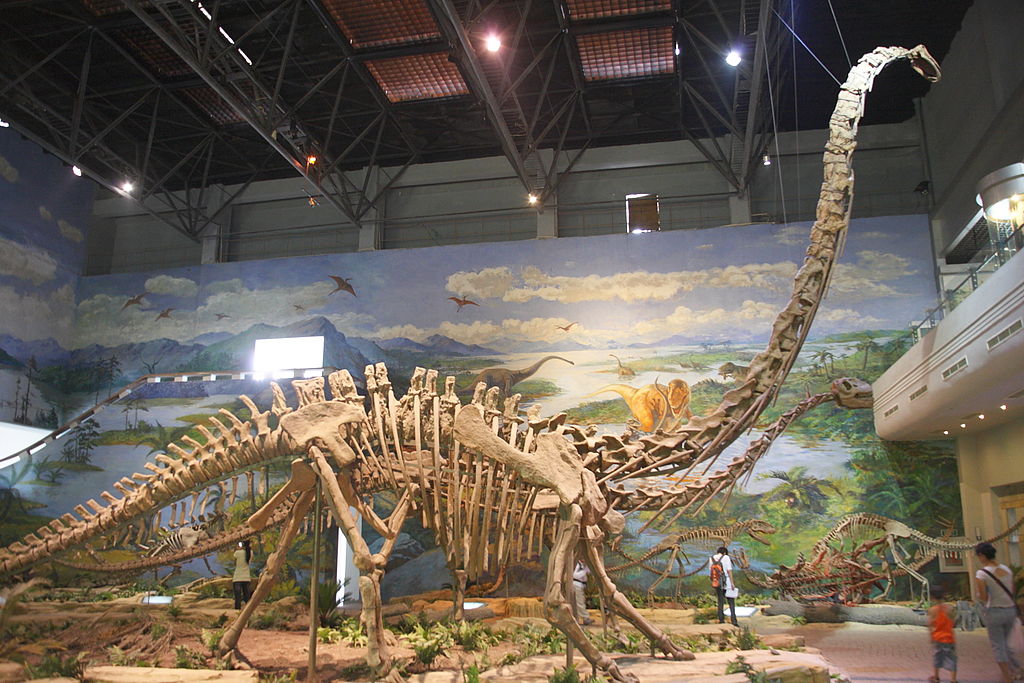Sauropods, a group of dinosaurs, are of interest to scientists because they were among the most successful dinosaurs that ever lived. They have long necks, long tails, small heads, and four thick pillar-like legs. They are the type of dinosaur you imagine in your head when someone says the word, “dinosaur.” Evidence indicates that they may have been primarily vegetarian. They lived during the Middle Jurassic period, which lasted from about 174 to 163 million years ago. It was an important period in sauropod evolution.

Here’s an artist’s rendition of what a sauropod dinosaur probably looked like, roughly speaking.
Evidence of Middle Jurassic sauropods are not easy to find around the world. Fossilized dinosaur tracks, located in areas called “trackways,” provide some evidence of their history. French scientists recently found the first sauropod dinosaur trackway in a karstic cave in Southern France. A karstic cave is among one of the most common types of caves, formed from limestone.
There were many studies during the last decade to learn about track sites in Europe. Some of the trackways were found by other scientists in France for another group of dinosaurs, the theropods. However, until this study, there weren’t any tracks for Middle Jurassic sauropods in France. Even though it is typical to find track sites in caves, mines or railway tunnels, it’s rare to find them in natural karstic caves.
The Castelbouc karstic network is located in the northern part of the Causses Basin. The first dinosaur tracks were found by one of the research team members while doing a caving trip in 2015. After this discovery, they returned to the cave network three additional times between 2016 and 2018 to continue collecting data. The dinosaur tracks were located on the roof of an underground passage near the entrance area of The Castelbouc caves.

Example of a karst cave.
Using a technique called X-ray diffraction, they analyzed samples of the environment of this underground passage, referred to as “the Tunnel gallery,” to understand more about it – such as the types of sediment and minerals it was made of. They also analyzed the amount of carbonate minerals in the rocks using a technique called thermogravimetry. Scientists analyzed these rock characteristics to understand more about the timeline of when these fossils deposited, which can reveal greater detail about the evolutionary relationships of animals that formed the fossils.
This turned out to be useful. They found that the tunnel gallery is made of thin layers of many different types of limestone rock, each with different geochemistry. Also, each layer contained a unique set of “bioclasts,” which are skeletal fossil remains of once living animals typically found in limestone rock. Among the once living animals found here are bivalves (such as clams and mussels) gastropods (like snails and slugs), fish scales, and even fossilized wood.
The types of rocks found in this area are formed mostly by marl, limestone, marly limestone and oolithic limestone. The fact that this region contained so many different types of rock was hypothesized to be part of the reason why so many different animals once lived here – unique environmental conditions of the time allowed for unique rock to form later. The roof of the Tunnel Gallery consists of oolithic limestone with abundant marine bioclasts as well as rare microscopic wood remains.
As for the sauropods, the researchers were able to better connect their lineage to other events of the time. They distinguished that these pedal trackways can be classified as large sauropod trackways, approximately 75 centimeters long! Most of the trackways are found on the roof of Tunnel gallery at the interface of marly limestone bed. Due to erosion of the marly limestone, some of the pedal trackways were not well-preserved.

Example of fossilized dinosaur tracks. They’re about a meter long! Source: Paper
However, some of the pedal trackways show delicate details of claws, digits, and paw pads. Researchers used a meticulous technique called “systematic paleoichnology” to identify the tracks, which involves comparing physical traits of the tracks with other known samples. After these comparisons, they concluded that the tracks were made by a dinosaur from the Middle Jurassic period. This dinosaur was likely to be a member of a group of large sauropods called Titanosauriformes. The authors of this study claim that the Titanosauriformes were an earlier form of sauropods that existed thousands of years before a major expansion in species diversity of the Late Jurassic period.


